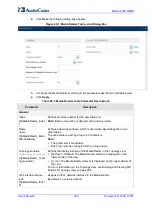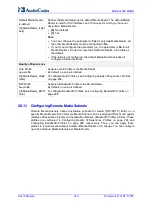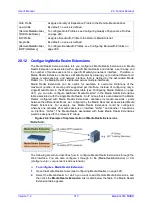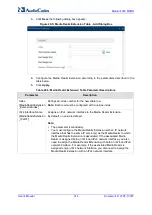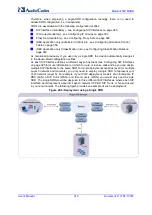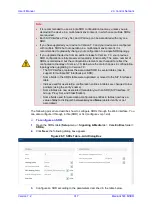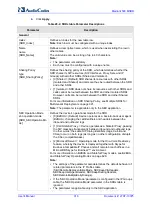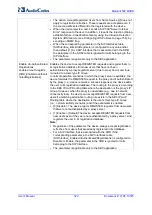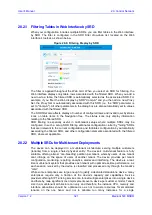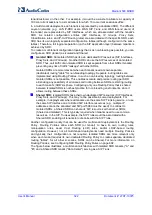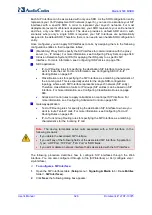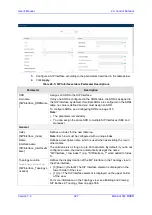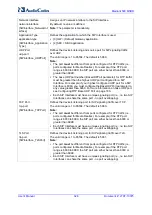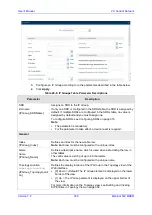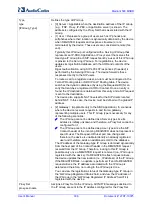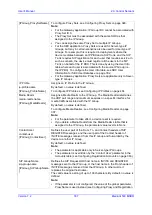
User's Manual
322
Document #: LTRT-10375
Mediant 500 MSBR
tenant/customer on the other. For example, it would be a waste to allocate a capacity of
100 concurrent sessions to a small tenant for which 10 concurrent sessions suffice.
In a multi-tenant deployment, each tenant is represented by a dedicated SRD. The different
Layer-3 networks (e.g., LAN IP-PBX users, WAN SIP Trunk, and WAN far-end users) of
the tenant are represented by SIP Interfaces, which are all associated with the tenant's
SRD. As related configuration entities (SIP Interfaces, IP Groups, Proxy Sets,
Classification rules, and IP-to-IP Routing rules) are associated with the specific SRD, each
SRD has its own logically separated configuration tables (although configured in the same
tables). Therefore, full logical separation (on the SIP application layer) between tenants is
achieved by SRD.
To create a multi-tenant configuration topology that is as non-bleeding as possible, you can
configure an SRD (tenant) as
Isolated
and
Shared
:
Isolated SRD:
An Isolated SRD has its own dedicated SIP resources (SIP Interfaces,
Proxy Sets, and IP Groups). No other SRD can use the SIP resources of an Isolated
SRD. Thus, call traffic of an Isolated SRD is kept separate from other SRDs (tenants),
preventing any risk of traffic "leakage" with other SRDs.
Isolated SRDs are more relevant when each tenant needs its own separate
(dedicated) routing "table" for non-bleeding topology. Separate routing tables are
implemented using Routing Policies. In such a non-bleeding topology, routing between
Isolated SRDs is not possible. This enables accurate and precise routing per SRD,
eliminating any possibility of erroneous call routing between SRDs, restricting routing
to each tenant's (SRD's) sphere. Configuring only one Routing Policy that is shared
between Isolated SRDs is not best practice for non-bleeding environments, since it
allows routing between these SRDs.
Shared SRD:
Isolated SRDs have their own dedicated SIP resources (SIP Interfaces,
Proxy Sets, and IP Groups). This may not be possible in some deployments. For
example, in deployments where all tenants use the same SIP Trunking service, or use
the same SIP Interface due to limited SIP interface resources (e.g., multiple IP
addresses cannot be allocated and SIP port 5060 must be used). In contrast to
Isolated SRDs, a Shared SRD can share its' SIP resources with all other SRDs
(Shared and Isolated). This is typically required when tenants need to use common
resources. In the SIP Trunk example, the SIP Trunk would be associated with a
Shared SRD, enabling all tenants to route calls with the SIP Trunk.
Another configuration entity that can be used for multi-tenant deployments is the Routing
Policy. Routing Policies allow each SRD (or tenant) to have its own routing rules,
manipulation rules, Least Cost Routing (LCR) rules, and/or LDAP-based routing
configuration. However, not all multi-tenant deployments need multiple Routing Policies
and typically, their configuration is not required. Isolated SRDs are more relevant only
when each tenant requires its own dedicated Routing Policy to create separate, dedicated
routing "tables"; for all other scenarios, SRDs can be Shared. For more information on
Routing Policies, see Configuring SBC Routing Policy Rules on page 692.
The figure below illustrates a multi-tenant architecture with Isolated SRD tenants ("A" and
"B") and a Shared SRD tenant ("Data Center") serving as a SIP Trunk:
Summary of Contents for Mediant 500 MSBR
Page 2: ......
Page 33: ...Part I Getting Started with Initial Connectivity ...
Page 34: ......
Page 36: ...User s Manual 36 Document LTRT 10375 Mediant 500 MSBR This page is intentionally left blank ...
Page 40: ...User s Manual 40 Document LTRT 10375 Mediant 500 MSBR This page is intentionally left blank ...
Page 45: ...Part II Management Tools ...
Page 46: ......
Page 48: ...User s Manual 48 Document LTRT 10375 Mediant 500 MSBR This page is intentionally left blank ...
Page 115: ...Part III General System Settings ...
Page 116: ......
Page 132: ...User s Manual 132 Document LTRT 10375 Mediant 500 MSBR This page is intentionally left blank ...
Page 137: ...Part IV General VoIP Configuration ...
Page 138: ......
Page 290: ...User s Manual 290 Document LTRT 10375 Mediant 500 MSBR This page is intentionally left blank ...
Page 306: ...User s Manual 306 Document LTRT 10375 Mediant 500 MSBR This page is intentionally left blank ...
Page 380: ...User s Manual 380 Document LTRT 10375 Mediant 500 MSBR This page is intentionally left blank ...
Page 454: ...User s Manual 454 Document LTRT 10375 Mediant 500 MSBR This page is intentionallty left blank ...
Page 455: ...Part V Gateway Application ...
Page 456: ......
Page 460: ...User s Manual 460 Document LTRT 10375 Mediant 500 MSBR This page is intentionally left blank ...
Page 484: ...User s Manual 484 Document LTRT 10375 Mediant 500 MSBR This page is intentionally left blank ...
Page 494: ...User s Manual 494 Document LTRT 10375 Mediant 500 MSBR This page is intentionally left blank ...
Page 625: ...Part VI Session Border Controller Application ...
Page 626: ......
Page 654: ...User s Manual 654 Document LTRT 10375 Mediant 500 MSBR This page is intentionally left blank ...
Page 656: ...User s Manual 656 Document LTRT 10375 Mediant 500 MSBR This page is intentionally left blank ...
Page 741: ...Part VII Cloud Resilience Package ...
Page 742: ......
Page 751: ...Part VIII Data Router Configuration ...
Page 752: ......
Page 753: ......
Page 754: ......
Page 756: ...User s Manual 756 Document LTRT 10375 Mediant 500 MSBR This page is intentionally left blank ...
Page 757: ...Part IX Maintenance ...
Page 758: ......
Page 834: ...User s Manual 834 Document LTRT 10375 Mediant 500 MSBR This page is intetnionaly left blank ...
Page 837: ...Part X Status Performance Monitoring and Reporting ...
Page 838: ......
Page 848: ...User s Manual 848 Document LTRT 10375 Mediant 500 MSBR This page is intentionally left blank ...
Page 852: ...User s Manual 852 Document LTRT 10375 Mediant 500 MSBR This page is intentionally left blank ...
Page 854: ...User s Manual 854 Document LTRT 10375 Mediant 500 MSBR This page is intentionally left blank ...
Page 878: ...User s Manual 878 Document LTRT 10375 Mediant 500 MSBR This page is intentionally left blank ...
Page 880: ...User s Manual 880 Document LTRT 10375 Mediant 500 MSBR This page is intentionally left blank ...
Page 926: ...User s Manual 926 Document LTRT 10375 Mediant 500 MSBR This page is intentionally left blank ...
Page 927: ...Part XI Diagnostics ...
Page 928: ......
Page 950: ...User s Manual 950 Document LTRT 10375 Mediant 500 MSBR This page is intentionally left blank ...
Page 954: ...User s Manual 954 Document LTRT 10375 Mediant 500 MSBR This page is intentionally left blank ...
Page 956: ...User s Manual 956 Document LTRT 10375 Mediant 500 MSBR This page is intentionally left blank ...
Page 958: ...User s Manual 958 Document LTRT 10375 Mediant 500 MSBR This page is intentionally left blank ...
Page 974: ...User s Manual 974 Document LTRT 10375 Mediant 500 MSBR This page is intentionally left blank ...
Page 976: ...User s Manual 976 Document LTRT 10375 Mediant 500 MSBR This page is intentionally left blank ...
Page 977: ...Part XII Appendix ...
Page 978: ......
Page 982: ...User s Manual 982 Document LTRT 10375 Mediant 500 MSBR This page is intentionally left blank ...

